

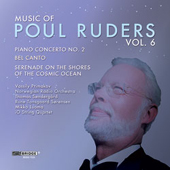
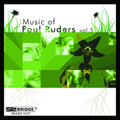
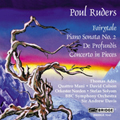
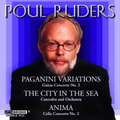
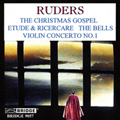
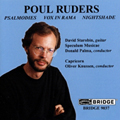
1) Symphony No. 4 "An Organ Symphony" (2008/9)
2) Trio Transcendentale (2010)
3) Songs and Rhapsodies (2010/11)
This disc presents Poul Ruders's latest orchestral composition, a 31 minute "Organ Symphony" in four movements, featuring
a superbly wrought organ part played by Danish virtuoso, Flemming Dreisig. The brilliantly orchestrated Symphony No. 4
is perhaps Ruders' most extroverted work to date. Ruders composed his Trio Transcendentale as the set piece for the Carl Nielsen
International Organ Competition, and it is recorded here by the winner of the 2011 'Ruders Prize', the British organist, Nicholas Wearne.
Songs and Rhapsodies is a 25 minute suite, written for the Danish accordionist Frode Andersen and the
woodwind quintet of Athelas, Denmark's foremost new music ensemble. Poul Ruders Vol. 7 is the follow-up to last year's Vol. 6
(BRIDGE 9336), which was a Gramophone finalist for 'Best Contemporary Music Recording of the Year." {Bridge Records}
Definitely one of my favorite composers, and one that I would rank amongst the top 5 living composers, Poul Ruders (b. 1949) is
considered one of the most important contemporary Danish composers. I believe one of the reasons why I admire his work so much is that, unlike so many
other composers, he doesn't seem to be afflicted with a pre-formulated style that determines the outcome of his music. He writes based on the instrumental
forces at hand, and like a chameleon, conforms to the subject matter or mood of a piece, rather than have the piece conform to a style. His ace in the
hole is his wonderful and inventive orchestration techniques. By creating odd or unusual instrument combinations, he often discovers new and vibrant
orchestral colors, or sounds that you would never think could emanate from a symphony orchestra. And none of this sounds gimmicky, forced, artificial,
or fabricated. These "new" orchestral sounds were always there. It just took someone like Ruders to unearth them. This orchestration technique is
one of his long standing trademarks, and is again one of the strong points of the music on this new recording.
The Symphony No. 4 (An Organ Symphony) joins the surprisingly long list of works for pipe organ and orchestra written
over the centuries by composers ranging from Kalevi Aho to Jan Zimmer, and many more in between. Yet only a handful ever seem to have gained
prominence, like the Saint-SaŽns Symphony No. 3, Handel Organ Concertos, Copland Symphony for Organ and Orchestra, and the Widor Organ Symphonies.
This new work, which saw its world premiŤre just last year in 2011, should have no problem grabbing the world's attention. Unlike the famous Saint-SaŽns,
this is not a concertante piece showcasing the pipe organ as a solo instrument set apart from the orchestra itself. It is more like a symphonic work for
full orchestra including a pipe organ. The organ is simply an extra instrument playing a part in creating the orchestral fabric and colors that fuel this music.
And this is where Poul Ruders plies his magic. The organ is simply employed as what it is, a wind instrument, nestled within the orchestral forces. Not
to the point of being a wallflower mind you. It does step forward a few times to lead the way, but as in most of Ruders' music, it's the interaction between
it and the other orchestral instruments that really makes the day. From the brooding, eerie and desolate landscape of the opening movement to the
semi-anthemic passages of the final movement, the organ and orchestra mesh to create evocative and memorable sounds, producing that aural candy
Ruders is known for. Organist Flemming Dreisig, who did all of us organ buffs a favor by recording Rued Langgaard's Messis
reviewed here,
does an excellent job of conveying the music's emotional and psychological state rather than it's strictly technical aspects. At the risk of repeating
myself, let me reiterate that there is nothing gimmicky or pre-formulated about this music. It is most likely as good a 21st century symphonic work as
you will ever get. Most composers these days seem to consider the symphony to be an outdated form. Really. Or is it simply that they don't have the
skills to write one.
The Trio Transcendentale, performed brilliantly by organist Nicholas Wearne, is a solo organ work
submitted for the 2011 Carl Nielsen Organ Competition, as a piece to challenge an organist's skill and nerves. Like the title suggests, it is written in
three individual parts, two keyboards and pedals, but unlike the famous Bach Trio Sonatas in which the three parts compliment each other with
impeccable counterpoint, this short 4 minute piece quickly becomes a split-personality, schizophrenic nightmare, of which the last few bars alone would
drive any organist insane because of their complexity.
And again, the Songs and Rhapsodies brings together an unusual combination of instruments. Scored for accordion and
wind quintet, somewhat like his 2004 Serenade on the Shores of the Cosmic Ocean for accordion and string quartet, it opens up a whole
new world of sonic possibilities. Personally, I've always considered the accordion to be a unidimensional, unexpressive and artificial sounding instrument.
But under this composer's vision, and the commited playing of Frode Andersen, it simply springs to life. As Ruders himself points
out: "this piece gives rise to numerous fascinating and unexpected sonorous encounters". The wind ensemble Athelas Sinfonietta
Copenhagen and the accordion, also a wind instrument itself, blend together seamlessly to somehow create a new instrument. And all of these
sonic pleasures are wrapped up in a masterful suite of 12 movements just as frivolous as they are profound.
For those of you looking to expand your musical horizons as well as your CD collection, this captivating series of recordings by Bridge Records,
which casts a wide net over the music of Poul Ruders, deserves some real estate on your shelves.
Jean-Yves Duperron - March 2012